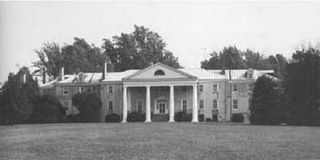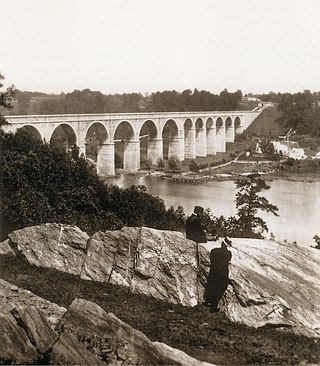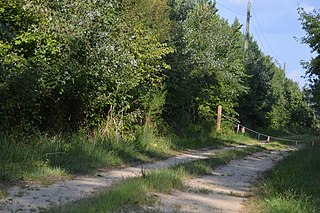
Samuel Francis Du Pont was a rear admiral in the United States Navy, and a member of the prominent Du Pont family. In the Mexican–American War, Du Pont captured San Diego, and was made commander of the California naval blockade. Through the 1850s, he promoted engineering studies at the United States Naval Academy, to enable more mobile and aggressive operations. In the American Civil War, he played a major role in making the Union blockade effective, but was controversially blamed for the failed attack on Charleston, South Carolina in April 1863.

The River Taff is a river in Wales. It rises as two rivers in the Brecon Beacons; the Taf Fechan and the Taf Fawr before becoming one just north of Merthyr Tydfil. Its confluence with the River Severn estuary is in Cardiff.

James Madison's Montpelier, located in Orange County, Virginia, was the plantation house of the Madison family, including Founding Father and fourth president of the United States James Madison and his wife, Dolley. The 2,650-acre (10.7 km2) property is open seven days a week with the mission of engaging the public with the enduring legacy of Madison's most powerful idea: government by the people.

Fort Nisqually was an important fur trading and farming post of the Hudson's Bay Company in the Puget Sound area, part of the Hudson's Bay Company's Columbia Department. It was located in what is now DuPont, Washington. Today it is a living history museum located in Tacoma, Washington, USA, within the boundaries of Point Defiance Park. The Fort Nisqually Granary, moved along with the Factor's House from the original site of the second fort to this park, is a U.S. National Historic Landmark. Built in 1843, the granary is the oldest building in Washington state and one of the only surviving examples of a Hudson's Bay Company "post-and-plank" structure. The Factor's House and the granary are the only surviving Hudson's Bay Company buildings in the United States.

The Croton Aqueduct or Old Croton Aqueduct was a large and complex water distribution system constructed for New York City between 1837 and 1842. The great aqueducts, which were among the first in the United States, carried water by gravity 41 miles (66 km) from the Croton River in Westchester County to reservoirs in Manhattan. It was built because local water resources had become polluted and inadequate for the growing population of the city. Although the aqueduct was largely superseded by the New Croton Aqueduct, which was built in 1890, the Old Croton Aqueduct remained in service until 1955.

The Jackson Homestead, located at 527 Washington Street, in the village of Newton Corner, in Newton, Massachusetts, is an historic house that served as a station on the Underground Railroad before the Civil War.

The Hartland Covered Bridge in Hartland, New Brunswick, is the world's longest covered bridge, at 1,282 feet (391 m) long. It crosses the Saint John River from Hartland to Somerville, New Brunswick, Canada. The framework consists of seven small Howe Truss bridges joined on six piers.

The Epping Forest was a historic, 58-acre (230,000 m2) estate in Jacksonville, Florida, United States where a luxurious riverfront mansion was built in the mid-1920s by industrialist Alfred I. du Pont and his third wife, Jessie Ball du Pont. It was added to the U.S. National Register of Historic Places in 1973 and has been restored to its original grandeur as the home of the Epping Forest Yacht Club. On April 18, 2012, the AIA's Florida Chapter placed the Epping Forest Yacht Club on its list of "Florida Architecture: 100 Years. 100 Places".

Lock and Dam No. 19 is a lock and dam located on the Upper Mississippi River near Keokuk, Iowa. In 2004, the facility was listed in the National Register of Historic Places as Lock and Dam No. 19 Historic District, #04000179 covering 1,605 acres (650 ha), 7 buildings, 12 structures, 1 object. The lock is owned and operated by the U.S. Army Corps of Engineers. The dam is owned and operated by Ameren Missouri.

The Missouri Governor's Mansion is a historic U.S. residence in Jefferson City, Missouri. It is located at 100 Madison Street. On May 21, 1969, it was added to the U.S. National Register of Historic Places. It is located in the Missouri State Capitol Historic District.

The Jacob Broom House, also known historically as Hagley, is a historic house on Christchurch Road near Montchanin, Delaware. It was built in 1795 by Founding Father Jacob Broom, one of the Delaware signers of the United States Constitution. The house was purchased in 1802 by Éleuthère Irénée du Pont, progenitor of the prominent Du Pont family and founder of the DuPont chemical concern, who established the Eleutherian Mills below the house on the banks of Brandywine Creek. The house, which remains in the hands of Du Pont descendants, was declared a National Historic Landmark in 1974 for its association with Broom.

Dunmere is a historic estate at 560 Ocean Road in Narragansett, Rhode Island.

The Clinton Furnace, also known as the Clinton Ironworks, is located along Clinton Road at the base of the Clinton Reservoir by the Clinton Brook in the township of West Milford in Passaic County, New Jersey, United States. The furnace was built in 1826 and was added to the National Register of Historic Places on June 18, 1976, for its significance in industry. The furnace is the last surviving structure of the iron community once known as Clinton.

The Dalton Covered Bridge, also called the Dalton Bridge, is a historic covered bridge that carries Joppa Road over the Warner River in Warner, New Hampshire. Its name refers to a nearby resident at the time of its construction. The bridge was built in 1853 by Joshua Sanborn, and its original abutments were built by George Sawyer and Webster Davis; all were local residents. The bridge has a span of 76 feet (23 m), with a total bridge length of 84 feet (26 m). The bridge is 17 feet (5.2 m) wide, with a road bed width of 14 feet (4.3 m), although guard rails have reduced its usable width to just under 13 feet (4.0 m).

Gibraltar, located at 2505 Pennsylvania Avenue in Wilmington, Delaware, is a country estate home dating from c. 1844 that is listed on the National Register of Historic Places. It takes its name from the Rock of Gibraltar, alluding to the high rocky outcrop on which the house was built. It is located just inside Wilmington's city limits and originally stood at the center of a much larger estate which has over time been reduced to the present area of about a city block in size. The house was originally built by John Rodney Brincklé and inherited by his brother's wife and children, before being bought in 1909 by Hugh Rodney Sharp, who was linked to the Du Pont family through marriage and work. Sharp expanded and remodeled the house, as well as commissioning the pioneering female landscape designer Marian Cruger Coffin to lay out the gardens.

Lower Louviers and Chicken Alley, also known as Louviers and Duck Street, is a historic home located near Wilmington in New Castle County, Delaware. It was added to the National Register of Historic Places in 1972.

Breck's Mill Area, also known as Breck's Mill Area-Henry Clay Village Historic District, is a national historic district located along Brandywine Creek in unincorporated New Castle County, Delaware, near Wilmington. It encompasses 56 contributing buildings, five contributing sites, and three contributing structures. The district encompasses The Mill, The Workers' houses, and The Mill Owner's Home.

Hurstville is a historic plantation house located at Kilmarnock, Northumberland County, Virginia. It was built about 1777, and is a 1+1⁄2-story, three-bay, double pile brick dwelling with a steep gable roof. It measures 28 feet by 30 feet, and features exterior end chimneys with two sets of tiled weatherings and a beveled water table. Also on the property are the contributing Ball family cemetery and the site of the Cress Field dwelling.

The Modern Housing Corporation Addition Historic District is a residential historic district located in Pontiac, Michigan and roughly bounded by Montcalm Street, Perry Street, Joslyn Avenue, Gage Street, Glenwood Street, and Nelson Street. It was listed on the National Register of Historic Places in 1989.

The Louviers Village Club, in Louviers, Colorado, was built in 1917 and was listed on the National Register of Historic Places in 1995.























